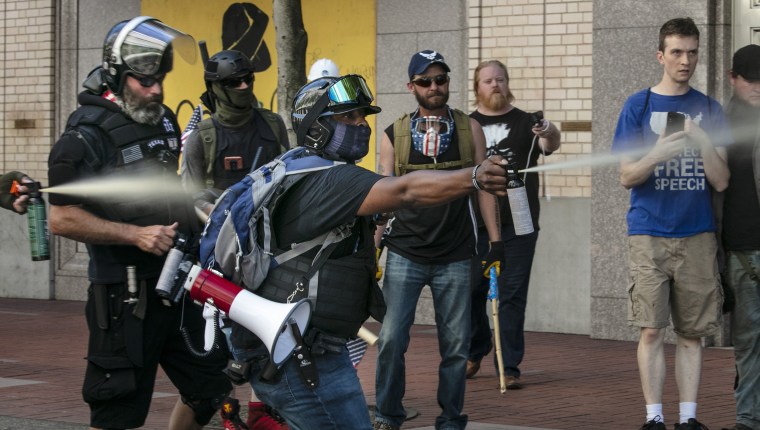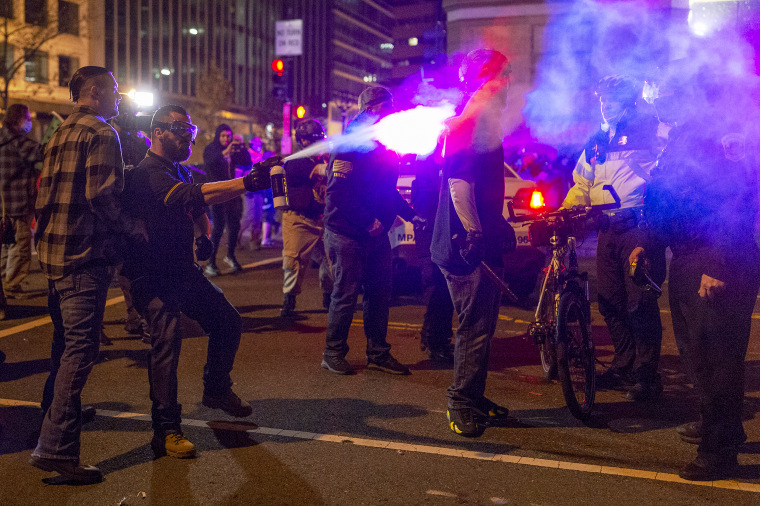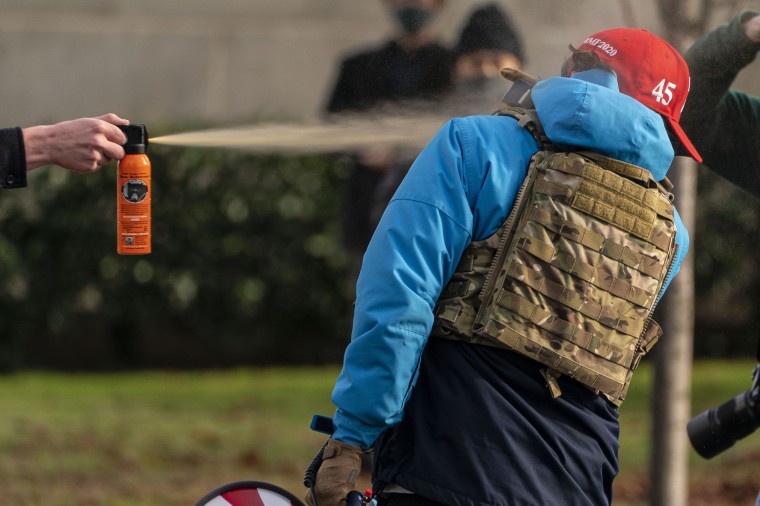Melissa Lewis, an independent journalist from Oregon, was documenting a far-right rally in Portland last August when she says a man rushed up and sprayed her with bear mace. The chemical seeped into her eyes and inside her ear canal, causing excruciating pain that sent her to the emergency room.
"It took three shots of fentanyl to get me to a place where I wasn’t screaming,” Lewis said.
Bear spray has been used as a weapon by civilians in a number of high-profile incidents in recent months.
The chemical irritant, which is similar to pepper spray but more potent, has been deployed by right-wing and left-wing protesters against one another and police in the Pacific Northwest. In Staten Island, New York, police say a man used it to incapacitate deli clerks in a series of robberies last December. And at least three people who participated in the Jan. 6 Capitol riot are accused of spraying police officers with bear repellent.

Two of the suspects were charged last week with using bear spray against Capitol Police Officer Brian Sicknick, who later died. It’s still not clear if the chemical caused or contributed to Sicknick’s death, but the incident has raised concerns about its escalating use in violent protests.
“This is not your average can of pepper spray,” said Dr. Rohini Haar, an emergency room physician in Oakland, California, and a medical advisor for the nonprofit Physicians for Human Rights.
“It’s being used as a weapon, and we need to treat it as such.”
Bear spray was developed in the 1980s after a spate of fatal bear attacks against people. It uses the same active ingredient as pepper spray — capsaicin, a chemical component of chili peppers — but at levels that can make it twice as powerful. And unlike pepper spray canisters, which shoot out a narrow stream, the larger bear mace bottles unleash a powerful and expanding cloud of chemical irritants designed to extend more than 30 feet and linger in the air.
“It creates a cone of the material so you have a good chance to hit the bear,” said Chris Servheen, a Montana-based wildlife biologist who served for 35 years as the U.S. Fish and Wildlife Service's national grizzly bear recovery coordinator.
But those same qualities also make it more dangerous when used against humans, experts say.
Few large-scale studies have been conducted on the health impacts of chemical irritants like pepper spray or tear gas. A 2017 review of the available documentation found that chemical irritants were rarely fatal and the vast majority of reported injuries were minor, but pepper spray and tear gas “can cause significant injuries as well as permanent disabilities.”
Haar, who led the study, said the more serious injuries involve respiratory problems among people with pre-existing conditions as well as chemical burns and other damage to the eyes.
“It’s basically like a hot acid in your eye,” said Haar, who is an adjunct professor of epidemiology at the School of Public Health, University of California, Berkeley. “These things are about 10,000 times more powerful than a store-bought habanero or your average jalapeño pepper.”

Unlike tear gas, pepper spray and bear mace are oil-based irritants, making them more difficult and more painful to wash off one’s body. Haar also said the faster the spray shoots out of the bottle the greater the chance for more serious injuries — another reason bear spray can be more dangerous than pepper spray when used against humans.
“Bear spray is ejected at a much higher speed because it goes so much farther,” she said.
The products are sold across the country, at niche outdoors retailers and major retailers.
Certain states, like New York, regulate the sale of capsaicin-based sprays, permitting it to be sold only in small quantities.
Matt Rothamel, owner of Blue Line Sports in Saranac Lake, New York, said it’s not uncommon for customers to ask about bear spray, which only comes in larger containers, but he only sells it to people licensed to carry it such as state wildlife personnel.
“I don’t even mention that we carry it and it’s not displayed on our shelves, but people ask for it,” Rothamel said.
Still, the product remains widely available and easy to obtain — even for people who live miles away from bear country.
New York prosecutors say Robert Summa, of Staten Island, sprayed bear mace in the face of workers during three separate bodega robberies from Dec. 8 to Dec. 31.
He was arrested after the New York Police Department released a surveillance video showing the moment the masked suspect unleashed the spray. Summa told investigators he “got the mace from Montana,” court documents say.

He has pleaded not guilty to robbery and assault charges. Summa’s lawyer, John Murphy, declined to comment.
The victim seen in the video was so traumatized by the incident that he stopped working at the store.
“He’s OK, but he’s scared,” said Ali Razza, manager of Forest Superette and Bagels.
Bear spray became a common sight at protests in Oregon and Washington state last year.
In Salem, Oregon, right-wing protesters angry over Covid-19 restrictions used bear spray against police while forcing their way into the state Capitol on Dec. 21, authorities said.
The officers “had protective gear on and they were able to work through it, but I know there were reports of tingling and odd sensations for hours after the event,” said Salem Police Lt. Trevon Upkes.
Upkes said the use of bear mace as a weapon came about as part of what he called an “arms race” among protesters and counterprotesters. “It’s a way of having some kind of offensive capability that won’t get you into trouble just for possessing it,” Upkes said.
Servheen, the Montana biologist and bear expert, said he fears the increased misuse of the sprays will lead to calls to ban the products, which he says would be terrible for bears. The spray irritates the bear's eyes, throat and nasal passageway, momentarily disabling it but causing no lasting effects.
“We would hate to see bear spray go away because it’s a very positive thing for bears,” Servheen said. “You can deter them without killing them. Unlike using something like a gun, they can walk away and go on with their business.”
David Nance, the chief executive officer of the SABRE personal security company, a major manufacturer of bear spray, said: "Bear spray should only be used to defend against a bear attack. The label states not to use on humans."
Melissa Lewis, the journalist who was sprayed at a Portland protest last August, said she has also been hit with pepper spray in the past but it’s nothing like the burning sensation caused by bear spray.

“I have epilepsy. I dislocated my own jaw in a grand mal (seizure). And this is still the worst pain I’ve ever been in,” Lewis said.
The blast of spray hit the side of her face and covered her hair at that protest in mid-August. Then she made the mistake of removing her face mask, causing the chemicals to drip into her eyes. At the same time, Lewis said, the skin on her arms and legs felt like it was burning up.
In the wake of the incident, Lewis filed a lawsuit against the man she says attacked her — Alan Swinney, a self-described Proud Boys member who was captured on videos posted to social media spraying mace into the crowd.
Swinney was arrested on Sept. 30 and charged with committing multiple offenses, including the unlawful use of mace, at two demonstrations in August, including the one where Lewis was sprayed.
His lawyer, Eric Wolfe, did not respond to a request for comment.
Lewis said she’s learned her lesson. Whenever she covers far-right rallies these days, she makes sure to protect herself from the threat of bear spray.
“No matter the weather, I’ll wear a raincoat and waterproof pants,” she said. “As I like to say, if it’s waterproof, it’s bear mace proof.”

